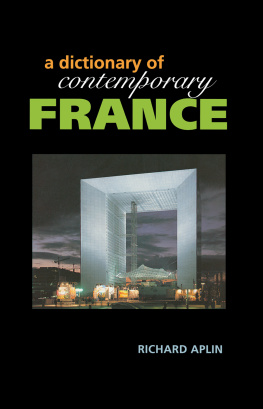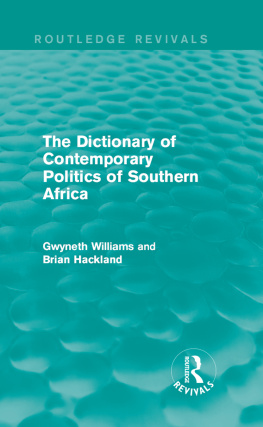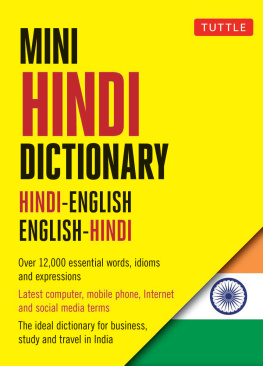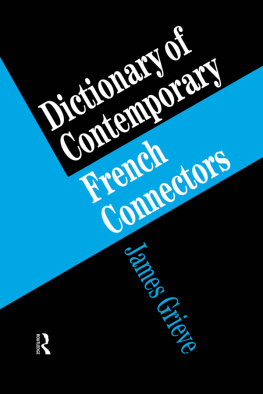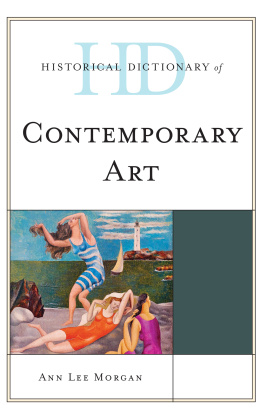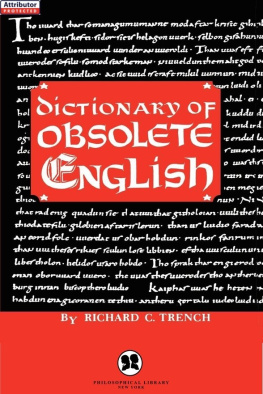a dictionary of
contemporary
FRANCE
RICHARD APLIN
with Joseph Montchamp
First published 1993 by Hodder & Stoughton
Published 2013 by Routledge
2 Park Square, Milton Park, Abingdon, Oxon OX14 4RN
711 Third Avenue, New York, NY, 10017, USA
Routledge is an imprint of the Taylor & Francis Group, an informa business
Copyright 1993 Richard Aplin
Copyright 1999 Richard Aplin
All rights reserved. This work is copyright. Permission is given for copies to be made of pages provided they are used exclusively within the institution for which this work has been purchased. For reproduction for any other purpose, permission must first be obtained in writing from the publishers.
A Cataloging-in-Publication record for this book is available from the Library of Congress.
ISBN 13: 978-1-579-58115-2 (hbk)
Typeset by Wearset, Boldon, Tyne and Wear.
To the memory of my father, Thomas James Aplin (19181992)
This dictionary is intended for readers of French who wish to have an explanation of the terms and acronyms they meet in the course of their study of the contemporary French press, where a bilingual dictionary does not provide an adequate reference. It is, therefore, addressed to all students of French beyond elementary level, as well as those readers whose knowledge of the language is advanced but who are unfamiliar with some of the detail of the contemporary French situation.
I have made no attempt to include tourist gazeteer or culinary references, as there already exists a large range of specialist works which meet those needs. Instead, I have concentrated on those terms which arise in material such as Le Point, Le Monde or LExpress which are unexplained in the original text because the writer assumes that no further explanation is necessary. These terms tend to relate to institutions, public figures and recent historical events. The final selection is necessarily personal, but I have attempted to apply some criteria which will explain why, for instance, some famous names seem to be missing. Generally speaking, I have interpreted contemporary as being post-1970. The reader will, however, find examples of events and personalities which pre-date this time, as there are some which simply cannot be excluded on grounds of date alone, as their influence on the contemporary scene is still of major significance.
The arrangement of the entries is on strict alphabetical lines, regardless of the spaces between words. Acronyms are provided in the main body of the text with their full form, and their explanation will be found under the full reference. Each word found in capital letters refers the reader to another keyword, and the intention is to indicate as wide a range of entries relating to the original keyword as possible so that as full a picture of the general area can be seen, without entries repeating the content of others.
I have taken the Quid 1992 interpretation of agglomration as the standard, and populations of dpartements and communes are also taken from that edition. Under entries for the dpartements, urban areas with populations of over 10,000 are listed, except in the Paris area, in which the minimum population for a commune to qualify is higher, the exact figure depending on the level of urbanisation of the area.
I have been immensely encouraged in the task of preparing this book by family, friends and colleagues. Joseph Montchamp has been an inspiration of many of the entries, and has also been invaluable in checking the accuracy of much of the rest. His comments have kept me amused as well as informed. Adrian Stokes and Tom Whiteside have encouraged me to keep going when problems arose, generously providing between them technological and moral support. My wife, Sheilah, has taken on board the detailed checking of the text, an unenviable task carried out under very tight deadlines. She and my daughters, Elizabeth and Caroline, have stoically tolerated my appropriation of their time and space in order to complete this project. If the book has any worth at all, it is due to the combined efforts of all who have been involved.
Richard Aplin
Leicester
Richard Aplin taught French in comprehensive schools in Wiltshire and Oxfordshire for 16 years before taking up posts in teacher education. He is currently Modern Languages Tutor and Head of the Secondary Postgraduate Certificate of Education course at the University of Leicester.
He has written and co-written a number of language course materials, including Introduction to Language and Orientations (Hodder & Stoughton), and has written scripts for BBC Schools Radio.
Contents
AB See: ALLOCATION DE BASE
ACADMICIEN
A member of one of the learned ACADMIES. The phrase Membre de lAcadmie, if not otherwise specified, normally refers to membership of the ACADMIE FRANAISE.
ACADMICIENNE See: YOURCENAR, MARGUERITE
ACADMIE
The administrative area for the organisation of the public education service, an acadmie is presided over by a RECTEUR who has overall responsibility for educational affairs in the area. A corps of INSPECTEURS, responsible to the recteur, maintains a monitoring and evaluation role over the LYCES. There are 26 acadmies in metropolitan France and two overseas (ANTILLES-GUYANE, RUNION).
The term acadmie is also used for the learned bodies composed of distinguished elected members, five of which form the INSTITUT DE FRANCE. LAcadmie usually refers to the ACADMIE FRANAISE. See also! INSPECTEUR DACADMIE
ACADMIE DES BEAUX-ARTS
Tracing its foundation back to 1648 when Le Brun founded the Acadmie royale de peinture et sculpture, and Colberts foundation of the Acadmie royale darchitecture in 1671, the Acadmie des beaux-arts now includes members from the fields of sculpture, painting, architecture, engraving, musical composition, cinema and television. There are also 15 distinguished foreign associates. The Acadmie des beaux-arts is affiliated to the INSTITUT DE FRANCE.
ACADMIE DES INSCRIPTIONS ET BELLES-LETTRES
Originally known at the time of its inception in 1663 as the PetiteAcadmie, it now has a role in supporting studies of antiquity and sponsors archaeological investigations. There are 45 full members. The Acadmie des inscriptions et belles-lettres is affiliated to the INSTITUT DE FRANCE.
ACADMIE DES SCIENCES
Founded in 1666, the Acadmie des sciences has 130 full members drawn from all the principal branches of science. It is divided into two major divisions mathematical and physical sciences, and chemical, natural and medical sciences each division being further sub-divided into sections. It maintains international links with similar national bodies. The Acadmie des sciences is affiliated to the INSTITUT DE FRANCE.
ACADMIE DES SCIENCES MORALES ET POLITIQUES
The most recently founded (1795) of the five ACADMIES in the INSTITUT DE FRANCE, it has 50 members, drawn largely from the fields of philosophy, ethics, sociology, law, economics, history and geography.
ACADMIE FRANAISE
Founded in 1635 by Louis XIII, at the behest of Cardinal Richelieu, with the role of affirming the French language as the national language of administration and culture, and of providing the standard model for national and international use. It is composed of 40 elected members, one of whom takes the role of permanent secretary. Each ACADMICIEN, who must be of French nationality, occupies a numbered FAUTEUIL until his or her death. The members are drawn largely from the ranks of eminent scholars or creative writers.


